Info System Design: Standard Chartered Bank - Critical Factors
VerifiedAdded on 2023/05/30
|11
|2253
|286
Report
AI Summary
This report critically evaluates Standard Chartered Bank's current management information system, highlighting its strengths and weaknesses. It proposes changes, specifically the integration of blockchain technology, to develop a new, more efficient system. The analysis covers the benefits of blockchain, such as streamlining processes, faster transactions, and increased transparency, while also addressing the challenges of implementation and data security. The proposed system architecture integrates blockchain with the existing legacy system, focusing on the data and service layers. Critical success factors for implementation include incorporating the new system while retaining transactional components and addressing potential risks like internet security and privacy issues. The report concludes that blockchain offers a more efficient and cost-effective solution compared to traditional management information systems, provided that proper encoding and privacy solutions are implemented.
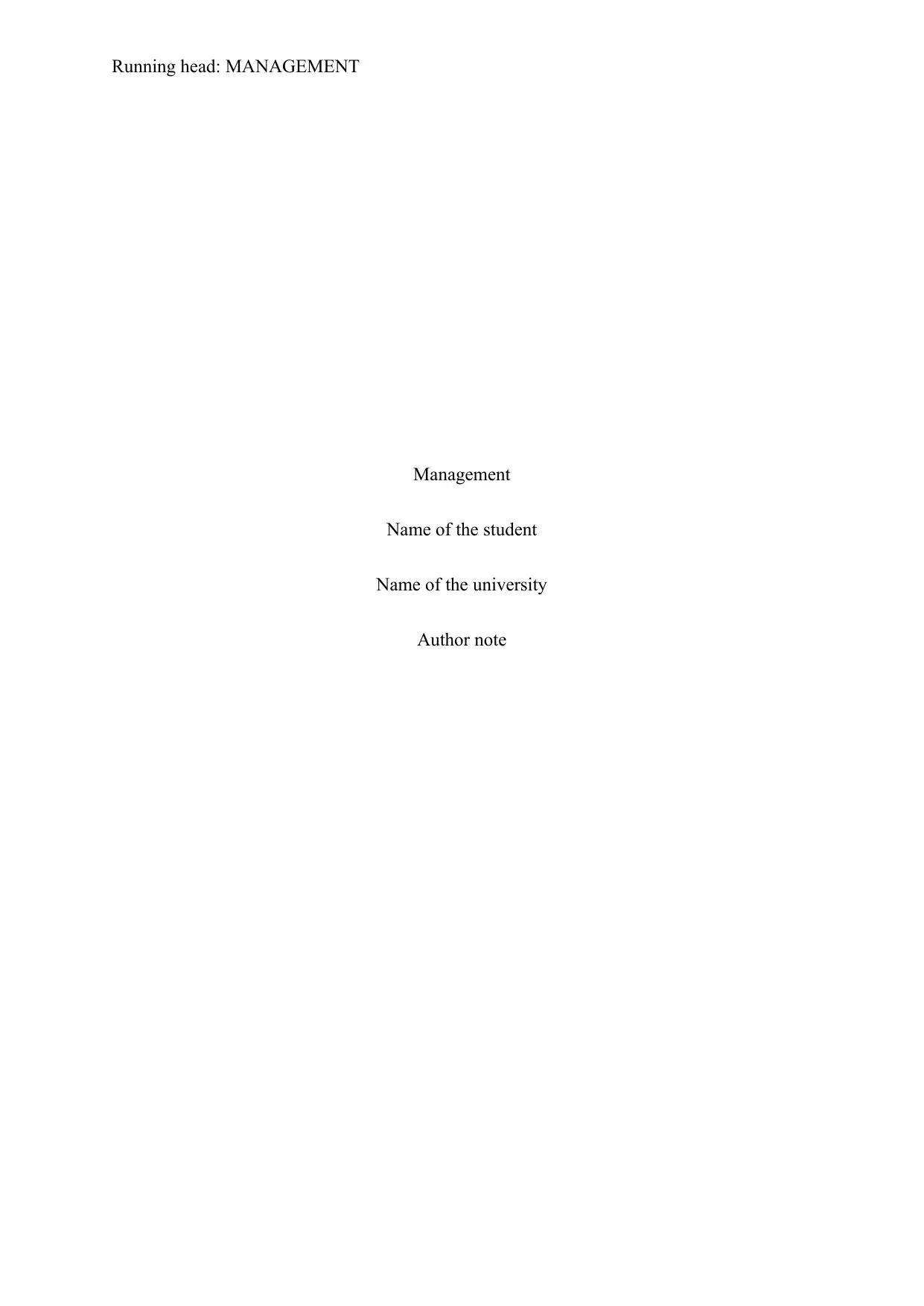
Running head: MANAGEMENT
Management
Name of the student
Name of the university
Author note
Management
Name of the student
Name of the university
Author note
Paraphrase This Document
Need a fresh take? Get an instant paraphrase of this document with our AI Paraphraser
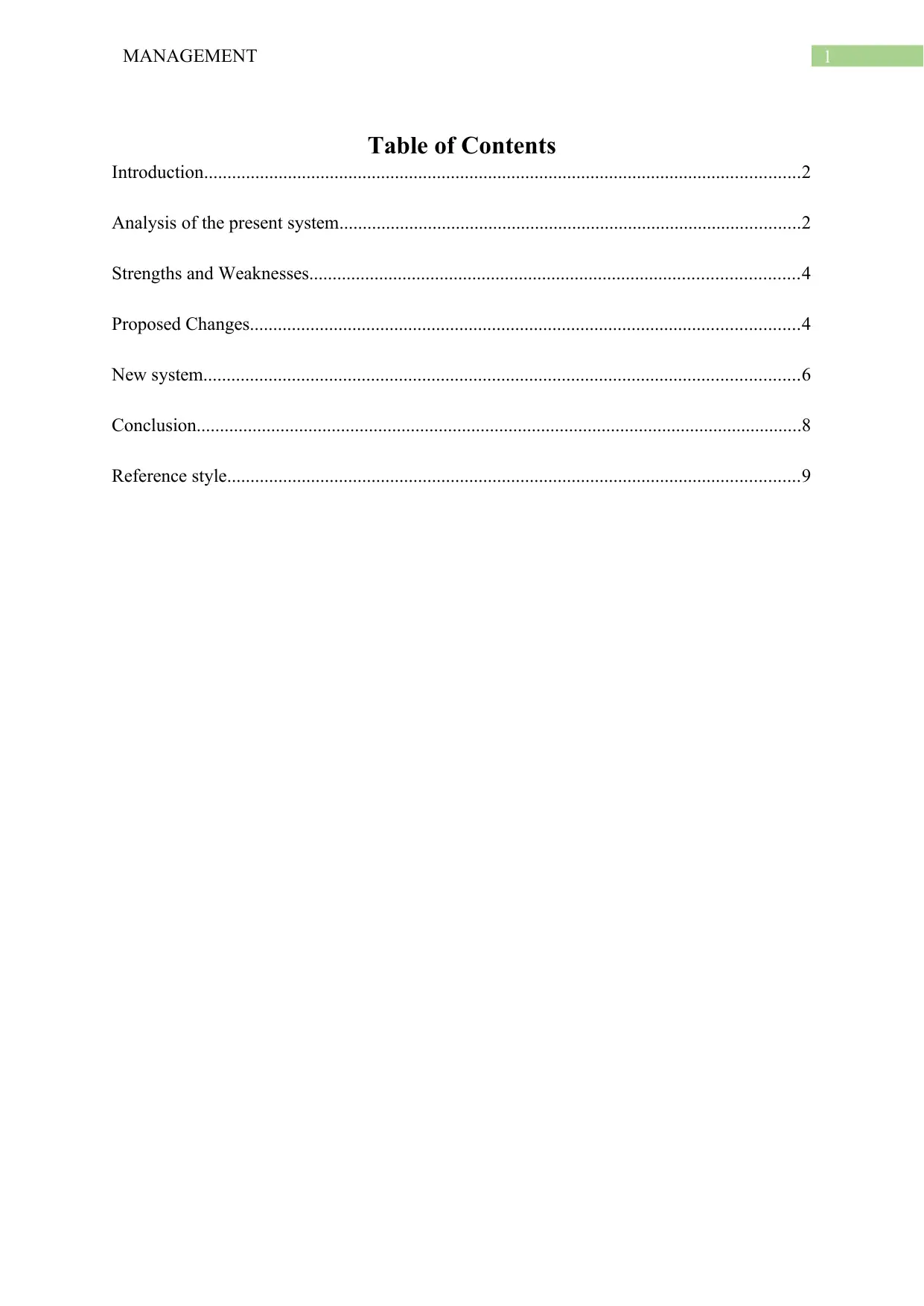
1MANAGEMENT
Table of Contents
Introduction................................................................................................................................2
Analysis of the present system...................................................................................................2
Strengths and Weaknesses.........................................................................................................4
Proposed Changes......................................................................................................................4
New system................................................................................................................................6
Conclusion..................................................................................................................................8
Reference style...........................................................................................................................9
Table of Contents
Introduction................................................................................................................................2
Analysis of the present system...................................................................................................2
Strengths and Weaknesses.........................................................................................................4
Proposed Changes......................................................................................................................4
New system................................................................................................................................6
Conclusion..................................................................................................................................8
Reference style...........................................................................................................................9
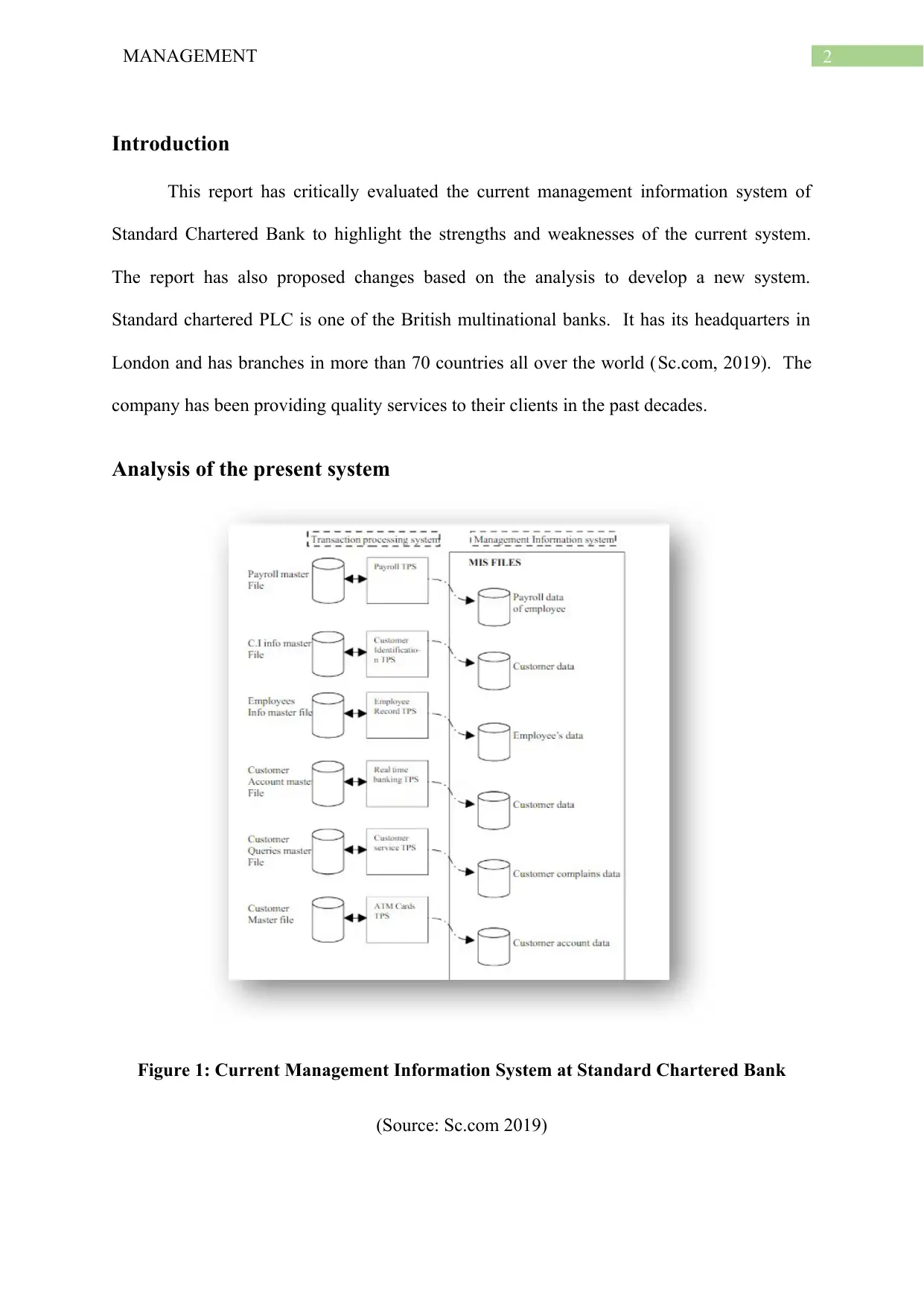
2MANAGEMENT
Introduction
This report has critically evaluated the current management information system of
Standard Chartered Bank to highlight the strengths and weaknesses of the current system.
The report has also proposed changes based on the analysis to develop a new system.
Standard chartered PLC is one of the British multinational banks. It has its headquarters in
London and has branches in more than 70 countries all over the world (Sc.com, 2019). The
company has been providing quality services to their clients in the past decades.
Analysis of the present system
Figure 1: Current Management Information System at Standard Chartered Bank
(Source: Sc.com 2019)
Introduction
This report has critically evaluated the current management information system of
Standard Chartered Bank to highlight the strengths and weaknesses of the current system.
The report has also proposed changes based on the analysis to develop a new system.
Standard chartered PLC is one of the British multinational banks. It has its headquarters in
London and has branches in more than 70 countries all over the world (Sc.com, 2019). The
company has been providing quality services to their clients in the past decades.
Analysis of the present system
Figure 1: Current Management Information System at Standard Chartered Bank
(Source: Sc.com 2019)
⊘ This is a preview!⊘
Do you want full access?
Subscribe today to unlock all pages.

Trusted by 1+ million students worldwide
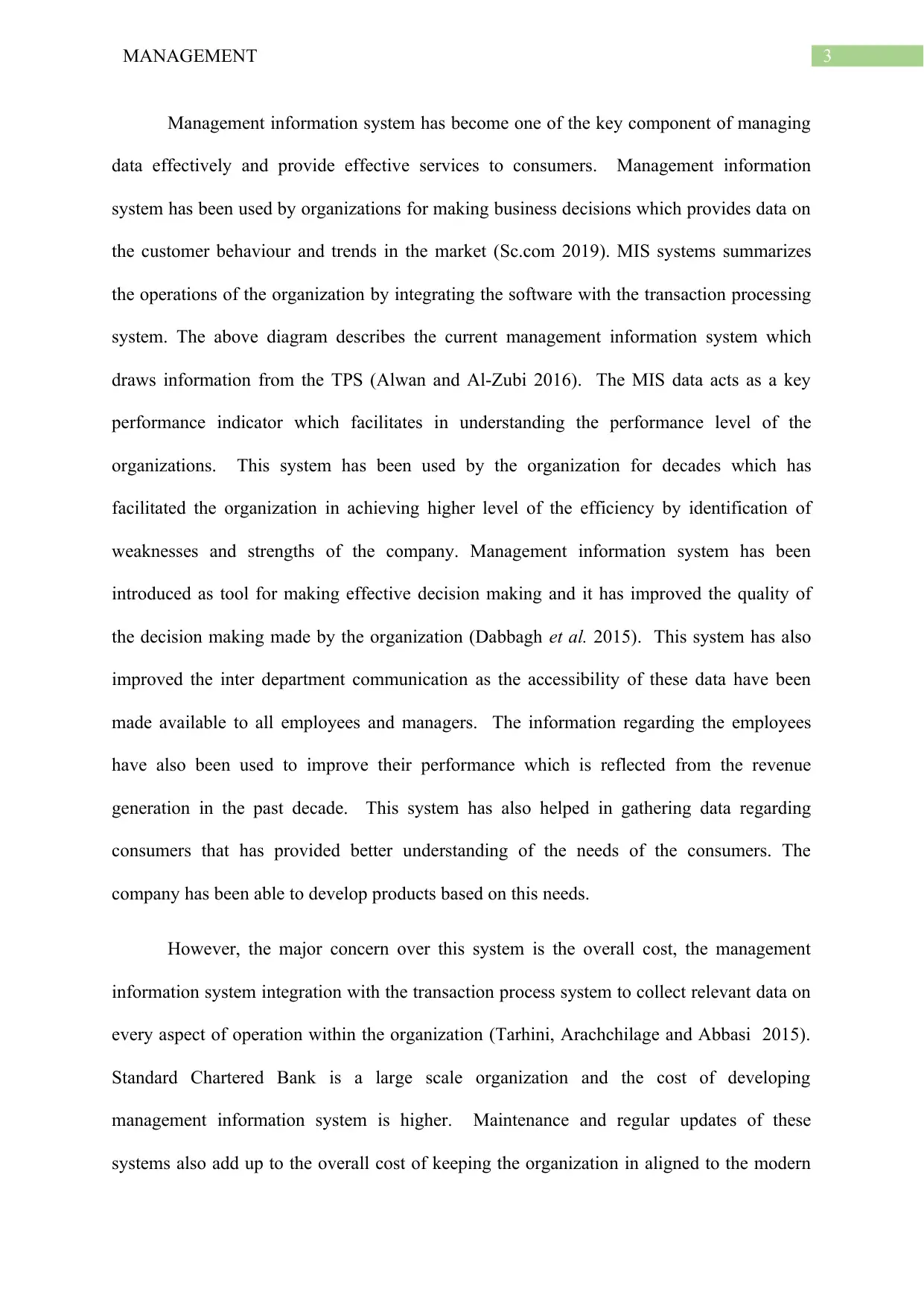
3MANAGEMENT
Management information system has become one of the key component of managing
data effectively and provide effective services to consumers. Management information
system has been used by organizations for making business decisions which provides data on
the customer behaviour and trends in the market (Sc.com 2019). MIS systems summarizes
the operations of the organization by integrating the software with the transaction processing
system. The above diagram describes the current management information system which
draws information from the TPS (Alwan and Al-Zubi 2016). The MIS data acts as a key
performance indicator which facilitates in understanding the performance level of the
organizations. This system has been used by the organization for decades which has
facilitated the organization in achieving higher level of the efficiency by identification of
weaknesses and strengths of the company. Management information system has been
introduced as tool for making effective decision making and it has improved the quality of
the decision making made by the organization (Dabbagh et al. 2015). This system has also
improved the inter department communication as the accessibility of these data have been
made available to all employees and managers. The information regarding the employees
have also been used to improve their performance which is reflected from the revenue
generation in the past decade. This system has also helped in gathering data regarding
consumers that has provided better understanding of the needs of the consumers. The
company has been able to develop products based on this needs.
However, the major concern over this system is the overall cost, the management
information system integration with the transaction process system to collect relevant data on
every aspect of operation within the organization (Tarhini, Arachchilage and Abbasi 2015).
Standard Chartered Bank is a large scale organization and the cost of developing
management information system is higher. Maintenance and regular updates of these
systems also add up to the overall cost of keeping the organization in aligned to the modern
Management information system has become one of the key component of managing
data effectively and provide effective services to consumers. Management information
system has been used by organizations for making business decisions which provides data on
the customer behaviour and trends in the market (Sc.com 2019). MIS systems summarizes
the operations of the organization by integrating the software with the transaction processing
system. The above diagram describes the current management information system which
draws information from the TPS (Alwan and Al-Zubi 2016). The MIS data acts as a key
performance indicator which facilitates in understanding the performance level of the
organizations. This system has been used by the organization for decades which has
facilitated the organization in achieving higher level of the efficiency by identification of
weaknesses and strengths of the company. Management information system has been
introduced as tool for making effective decision making and it has improved the quality of
the decision making made by the organization (Dabbagh et al. 2015). This system has also
improved the inter department communication as the accessibility of these data have been
made available to all employees and managers. The information regarding the employees
have also been used to improve their performance which is reflected from the revenue
generation in the past decade. This system has also helped in gathering data regarding
consumers that has provided better understanding of the needs of the consumers. The
company has been able to develop products based on this needs.
However, the major concern over this system is the overall cost, the management
information system integration with the transaction process system to collect relevant data on
every aspect of operation within the organization (Tarhini, Arachchilage and Abbasi 2015).
Standard Chartered Bank is a large scale organization and the cost of developing
management information system is higher. Maintenance and regular updates of these
systems also add up to the overall cost of keeping the organization in aligned to the modern
Paraphrase This Document
Need a fresh take? Get an instant paraphrase of this document with our AI Paraphraser
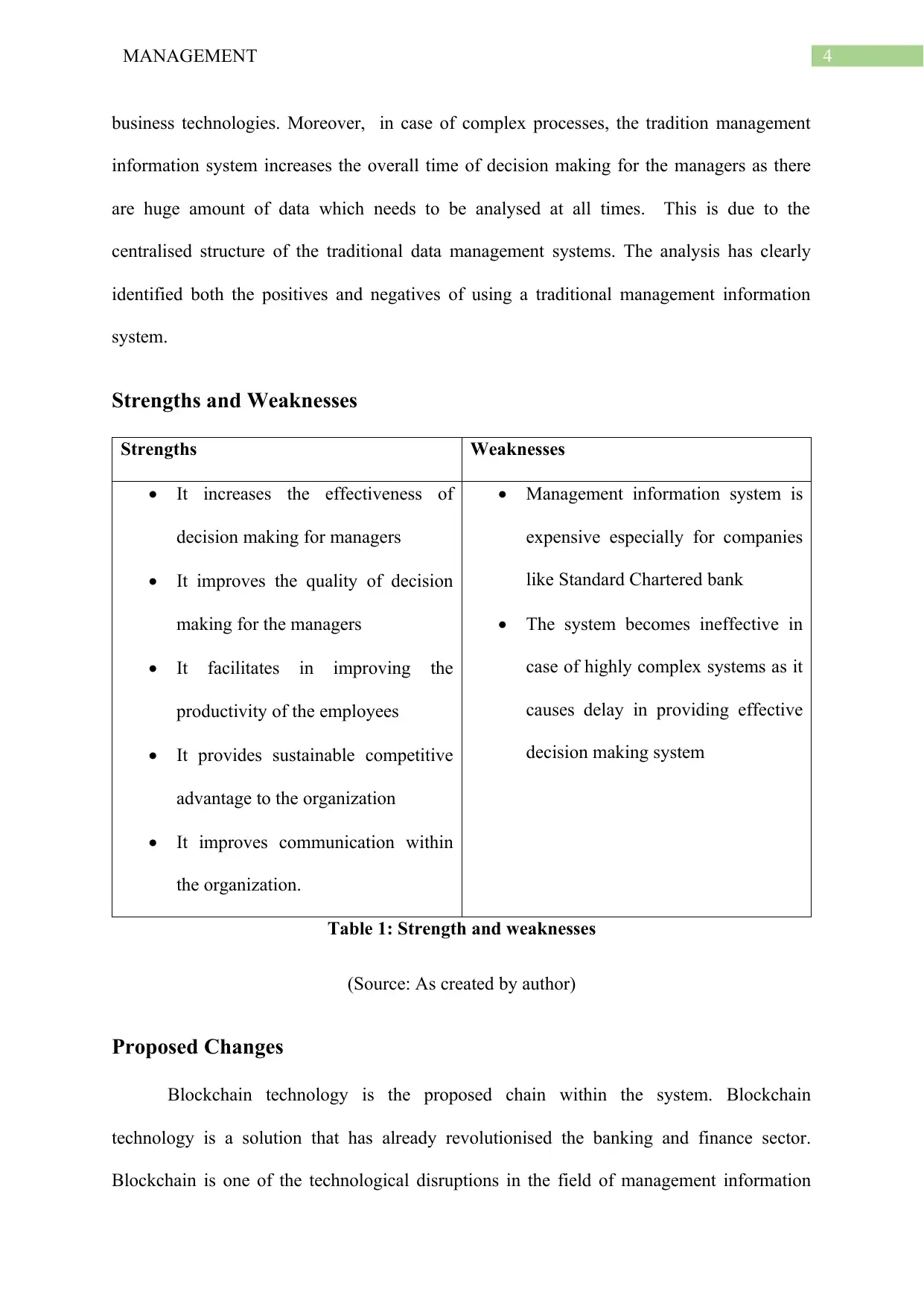
4MANAGEMENT
business technologies. Moreover, in case of complex processes, the tradition management
information system increases the overall time of decision making for the managers as there
are huge amount of data which needs to be analysed at all times. This is due to the
centralised structure of the traditional data management systems. The analysis has clearly
identified both the positives and negatives of using a traditional management information
system.
Strengths and Weaknesses
Strengths Weaknesses
It increases the effectiveness of
decision making for managers
It improves the quality of decision
making for the managers
It facilitates in improving the
productivity of the employees
It provides sustainable competitive
advantage to the organization
It improves communication within
the organization.
Management information system is
expensive especially for companies
like Standard Chartered bank
The system becomes ineffective in
case of highly complex systems as it
causes delay in providing effective
decision making system
Table 1: Strength and weaknesses
(Source: As created by author)
Proposed Changes
Blockchain technology is the proposed chain within the system. Blockchain
technology is a solution that has already revolutionised the banking and finance sector.
Blockchain is one of the technological disruptions in the field of management information
business technologies. Moreover, in case of complex processes, the tradition management
information system increases the overall time of decision making for the managers as there
are huge amount of data which needs to be analysed at all times. This is due to the
centralised structure of the traditional data management systems. The analysis has clearly
identified both the positives and negatives of using a traditional management information
system.
Strengths and Weaknesses
Strengths Weaknesses
It increases the effectiveness of
decision making for managers
It improves the quality of decision
making for the managers
It facilitates in improving the
productivity of the employees
It provides sustainable competitive
advantage to the organization
It improves communication within
the organization.
Management information system is
expensive especially for companies
like Standard Chartered bank
The system becomes ineffective in
case of highly complex systems as it
causes delay in providing effective
decision making system
Table 1: Strength and weaknesses
(Source: As created by author)
Proposed Changes
Blockchain technology is the proposed chain within the system. Blockchain
technology is a solution that has already revolutionised the banking and finance sector.
Blockchain is one of the technological disruptions in the field of management information
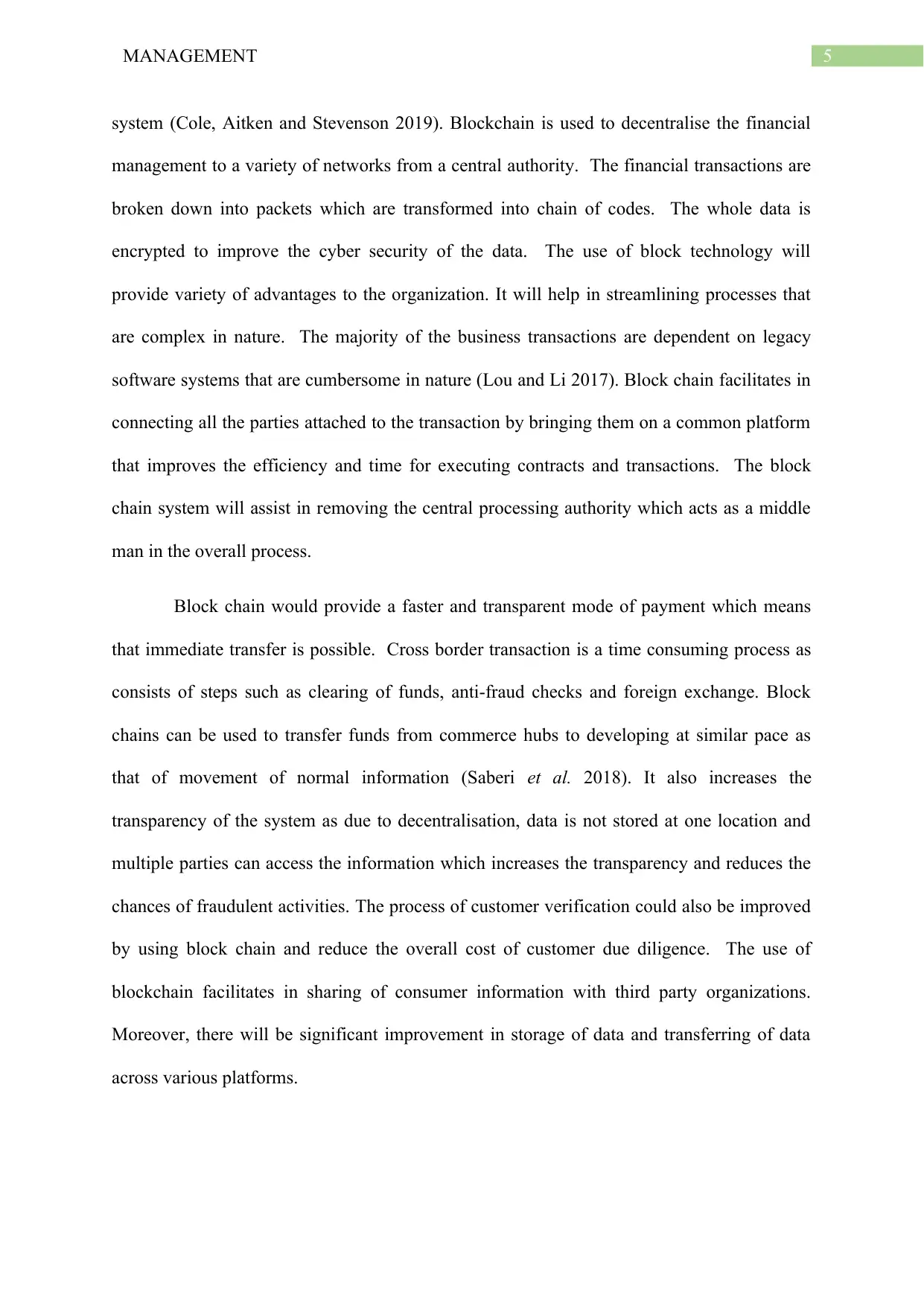
5MANAGEMENT
system (Cole, Aitken and Stevenson 2019). Blockchain is used to decentralise the financial
management to a variety of networks from a central authority. The financial transactions are
broken down into packets which are transformed into chain of codes. The whole data is
encrypted to improve the cyber security of the data. The use of block technology will
provide variety of advantages to the organization. It will help in streamlining processes that
are complex in nature. The majority of the business transactions are dependent on legacy
software systems that are cumbersome in nature (Lou and Li 2017). Block chain facilitates in
connecting all the parties attached to the transaction by bringing them on a common platform
that improves the efficiency and time for executing contracts and transactions. The block
chain system will assist in removing the central processing authority which acts as a middle
man in the overall process.
Block chain would provide a faster and transparent mode of payment which means
that immediate transfer is possible. Cross border transaction is a time consuming process as
consists of steps such as clearing of funds, anti-fraud checks and foreign exchange. Block
chains can be used to transfer funds from commerce hubs to developing at similar pace as
that of movement of normal information (Saberi et al. 2018). It also increases the
transparency of the system as due to decentralisation, data is not stored at one location and
multiple parties can access the information which increases the transparency and reduces the
chances of fraudulent activities. The process of customer verification could also be improved
by using block chain and reduce the overall cost of customer due diligence. The use of
blockchain facilitates in sharing of consumer information with third party organizations.
Moreover, there will be significant improvement in storage of data and transferring of data
across various platforms.
system (Cole, Aitken and Stevenson 2019). Blockchain is used to decentralise the financial
management to a variety of networks from a central authority. The financial transactions are
broken down into packets which are transformed into chain of codes. The whole data is
encrypted to improve the cyber security of the data. The use of block technology will
provide variety of advantages to the organization. It will help in streamlining processes that
are complex in nature. The majority of the business transactions are dependent on legacy
software systems that are cumbersome in nature (Lou and Li 2017). Block chain facilitates in
connecting all the parties attached to the transaction by bringing them on a common platform
that improves the efficiency and time for executing contracts and transactions. The block
chain system will assist in removing the central processing authority which acts as a middle
man in the overall process.
Block chain would provide a faster and transparent mode of payment which means
that immediate transfer is possible. Cross border transaction is a time consuming process as
consists of steps such as clearing of funds, anti-fraud checks and foreign exchange. Block
chains can be used to transfer funds from commerce hubs to developing at similar pace as
that of movement of normal information (Saberi et al. 2018). It also increases the
transparency of the system as due to decentralisation, data is not stored at one location and
multiple parties can access the information which increases the transparency and reduces the
chances of fraudulent activities. The process of customer verification could also be improved
by using block chain and reduce the overall cost of customer due diligence. The use of
blockchain facilitates in sharing of consumer information with third party organizations.
Moreover, there will be significant improvement in storage of data and transferring of data
across various platforms.
⊘ This is a preview!⊘
Do you want full access?
Subscribe today to unlock all pages.

Trusted by 1+ million students worldwide
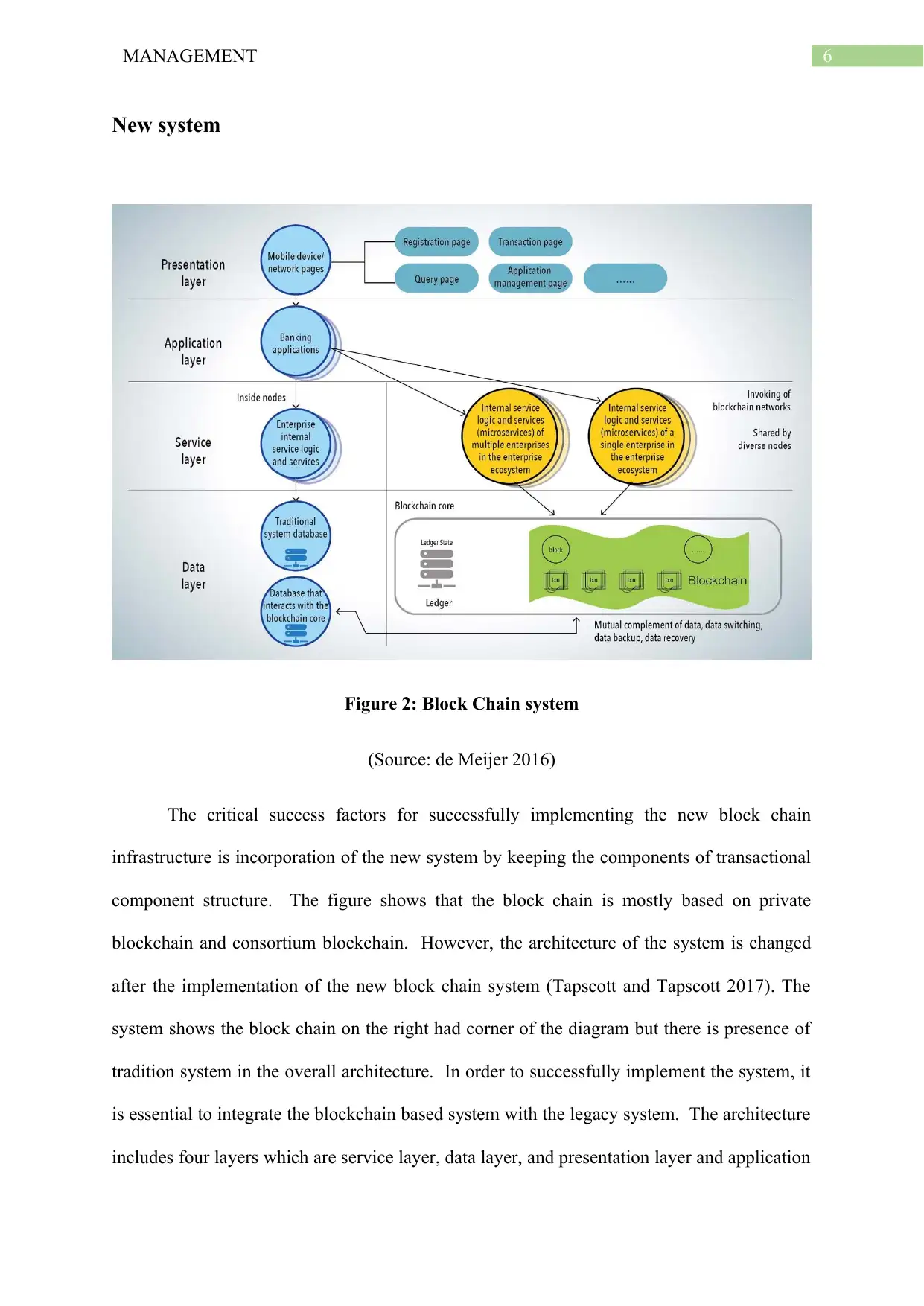
6MANAGEMENT
New system
Figure 2: Block Chain system
(Source: de Meijer 2016)
The critical success factors for successfully implementing the new block chain
infrastructure is incorporation of the new system by keeping the components of transactional
component structure. The figure shows that the block chain is mostly based on private
blockchain and consortium blockchain. However, the architecture of the system is changed
after the implementation of the new block chain system (Tapscott and Tapscott 2017). The
system shows the block chain on the right had corner of the diagram but there is presence of
tradition system in the overall architecture. In order to successfully implement the system, it
is essential to integrate the blockchain based system with the legacy system. The architecture
includes four layers which are service layer, data layer, and presentation layer and application
New system
Figure 2: Block Chain system
(Source: de Meijer 2016)
The critical success factors for successfully implementing the new block chain
infrastructure is incorporation of the new system by keeping the components of transactional
component structure. The figure shows that the block chain is mostly based on private
blockchain and consortium blockchain. However, the architecture of the system is changed
after the implementation of the new block chain system (Tapscott and Tapscott 2017). The
system shows the block chain on the right had corner of the diagram but there is presence of
tradition system in the overall architecture. In order to successfully implement the system, it
is essential to integrate the blockchain based system with the legacy system. The architecture
includes four layers which are service layer, data layer, and presentation layer and application
Paraphrase This Document
Need a fresh take? Get an instant paraphrase of this document with our AI Paraphraser
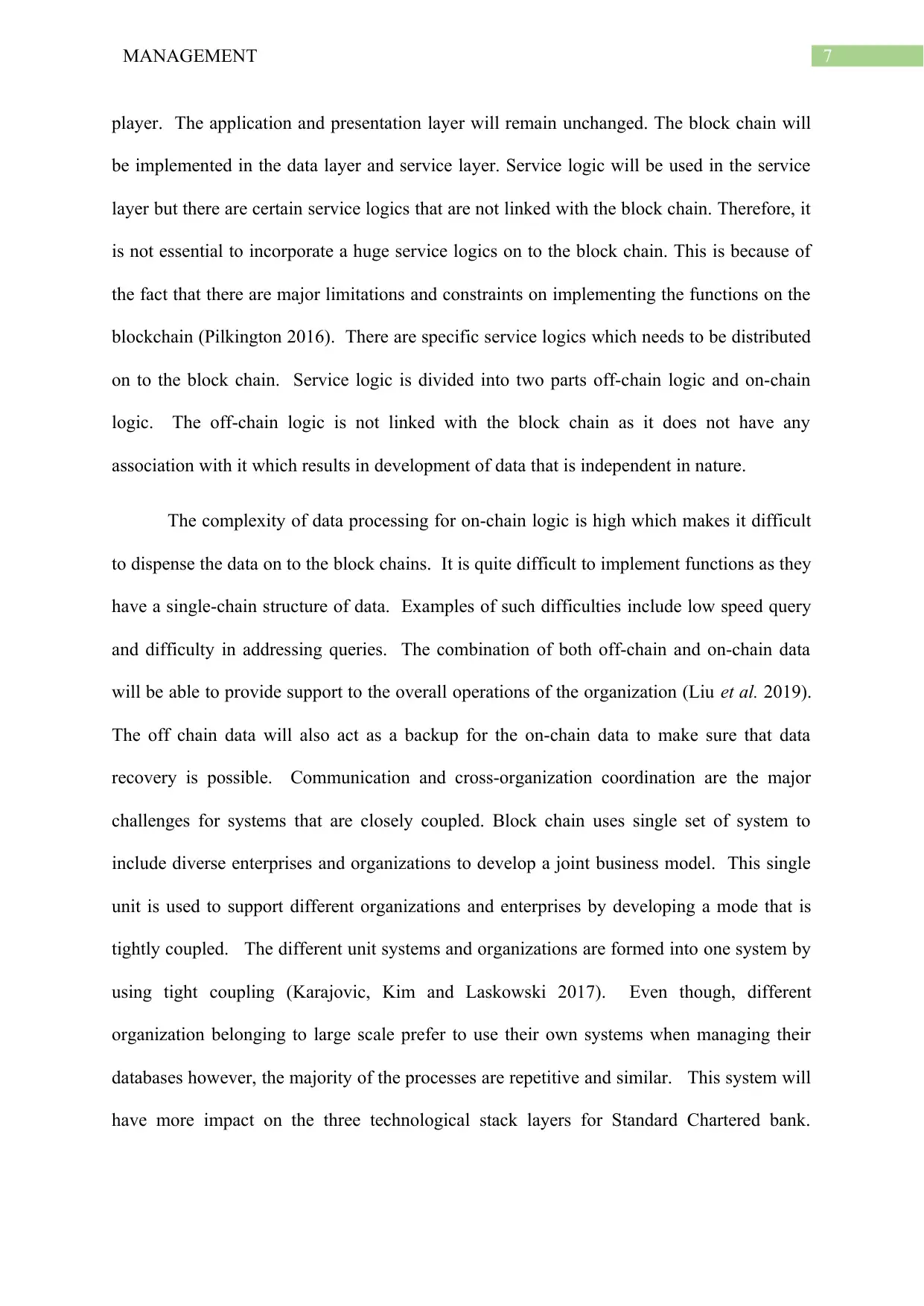
7MANAGEMENT
player. The application and presentation layer will remain unchanged. The block chain will
be implemented in the data layer and service layer. Service logic will be used in the service
layer but there are certain service logics that are not linked with the block chain. Therefore, it
is not essential to incorporate a huge service logics on to the block chain. This is because of
the fact that there are major limitations and constraints on implementing the functions on the
blockchain (Pilkington 2016). There are specific service logics which needs to be distributed
on to the block chain. Service logic is divided into two parts off-chain logic and on-chain
logic. The off-chain logic is not linked with the block chain as it does not have any
association with it which results in development of data that is independent in nature.
The complexity of data processing for on-chain logic is high which makes it difficult
to dispense the data on to the block chains. It is quite difficult to implement functions as they
have a single-chain structure of data. Examples of such difficulties include low speed query
and difficulty in addressing queries. The combination of both off-chain and on-chain data
will be able to provide support to the overall operations of the organization (Liu et al. 2019).
The off chain data will also act as a backup for the on-chain data to make sure that data
recovery is possible. Communication and cross-organization coordination are the major
challenges for systems that are closely coupled. Block chain uses single set of system to
include diverse enterprises and organizations to develop a joint business model. This single
unit is used to support different organizations and enterprises by developing a mode that is
tightly coupled. The different unit systems and organizations are formed into one system by
using tight coupling (Karajovic, Kim and Laskowski 2017). Even though, different
organization belonging to large scale prefer to use their own systems when managing their
databases however, the majority of the processes are repetitive and similar. This system will
have more impact on the three technological stack layers for Standard Chartered bank.
player. The application and presentation layer will remain unchanged. The block chain will
be implemented in the data layer and service layer. Service logic will be used in the service
layer but there are certain service logics that are not linked with the block chain. Therefore, it
is not essential to incorporate a huge service logics on to the block chain. This is because of
the fact that there are major limitations and constraints on implementing the functions on the
blockchain (Pilkington 2016). There are specific service logics which needs to be distributed
on to the block chain. Service logic is divided into two parts off-chain logic and on-chain
logic. The off-chain logic is not linked with the block chain as it does not have any
association with it which results in development of data that is independent in nature.
The complexity of data processing for on-chain logic is high which makes it difficult
to dispense the data on to the block chains. It is quite difficult to implement functions as they
have a single-chain structure of data. Examples of such difficulties include low speed query
and difficulty in addressing queries. The combination of both off-chain and on-chain data
will be able to provide support to the overall operations of the organization (Liu et al. 2019).
The off chain data will also act as a backup for the on-chain data to make sure that data
recovery is possible. Communication and cross-organization coordination are the major
challenges for systems that are closely coupled. Block chain uses single set of system to
include diverse enterprises and organizations to develop a joint business model. This single
unit is used to support different organizations and enterprises by developing a mode that is
tightly coupled. The different unit systems and organizations are formed into one system by
using tight coupling (Karajovic, Kim and Laskowski 2017). Even though, different
organization belonging to large scale prefer to use their own systems when managing their
databases however, the majority of the processes are repetitive and similar. This system will
have more impact on the three technological stack layers for Standard Chartered bank.
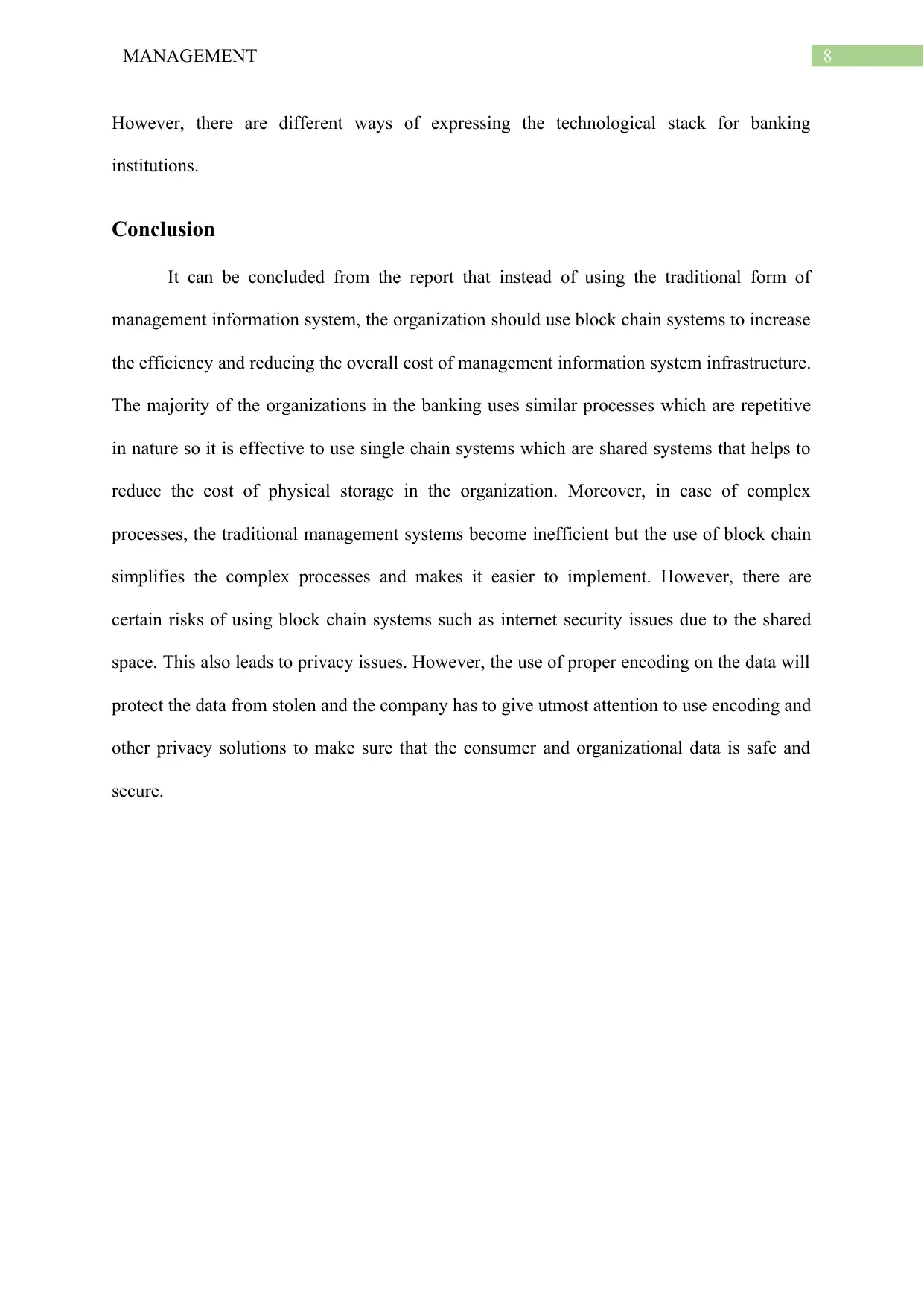
8MANAGEMENT
However, there are different ways of expressing the technological stack for banking
institutions.
Conclusion
It can be concluded from the report that instead of using the traditional form of
management information system, the organization should use block chain systems to increase
the efficiency and reducing the overall cost of management information system infrastructure.
The majority of the organizations in the banking uses similar processes which are repetitive
in nature so it is effective to use single chain systems which are shared systems that helps to
reduce the cost of physical storage in the organization. Moreover, in case of complex
processes, the traditional management systems become inefficient but the use of block chain
simplifies the complex processes and makes it easier to implement. However, there are
certain risks of using block chain systems such as internet security issues due to the shared
space. This also leads to privacy issues. However, the use of proper encoding on the data will
protect the data from stolen and the company has to give utmost attention to use encoding and
other privacy solutions to make sure that the consumer and organizational data is safe and
secure.
However, there are different ways of expressing the technological stack for banking
institutions.
Conclusion
It can be concluded from the report that instead of using the traditional form of
management information system, the organization should use block chain systems to increase
the efficiency and reducing the overall cost of management information system infrastructure.
The majority of the organizations in the banking uses similar processes which are repetitive
in nature so it is effective to use single chain systems which are shared systems that helps to
reduce the cost of physical storage in the organization. Moreover, in case of complex
processes, the traditional management systems become inefficient but the use of block chain
simplifies the complex processes and makes it easier to implement. However, there are
certain risks of using block chain systems such as internet security issues due to the shared
space. This also leads to privacy issues. However, the use of proper encoding on the data will
protect the data from stolen and the company has to give utmost attention to use encoding and
other privacy solutions to make sure that the consumer and organizational data is safe and
secure.
⊘ This is a preview!⊘
Do you want full access?
Subscribe today to unlock all pages.

Trusted by 1+ million students worldwide
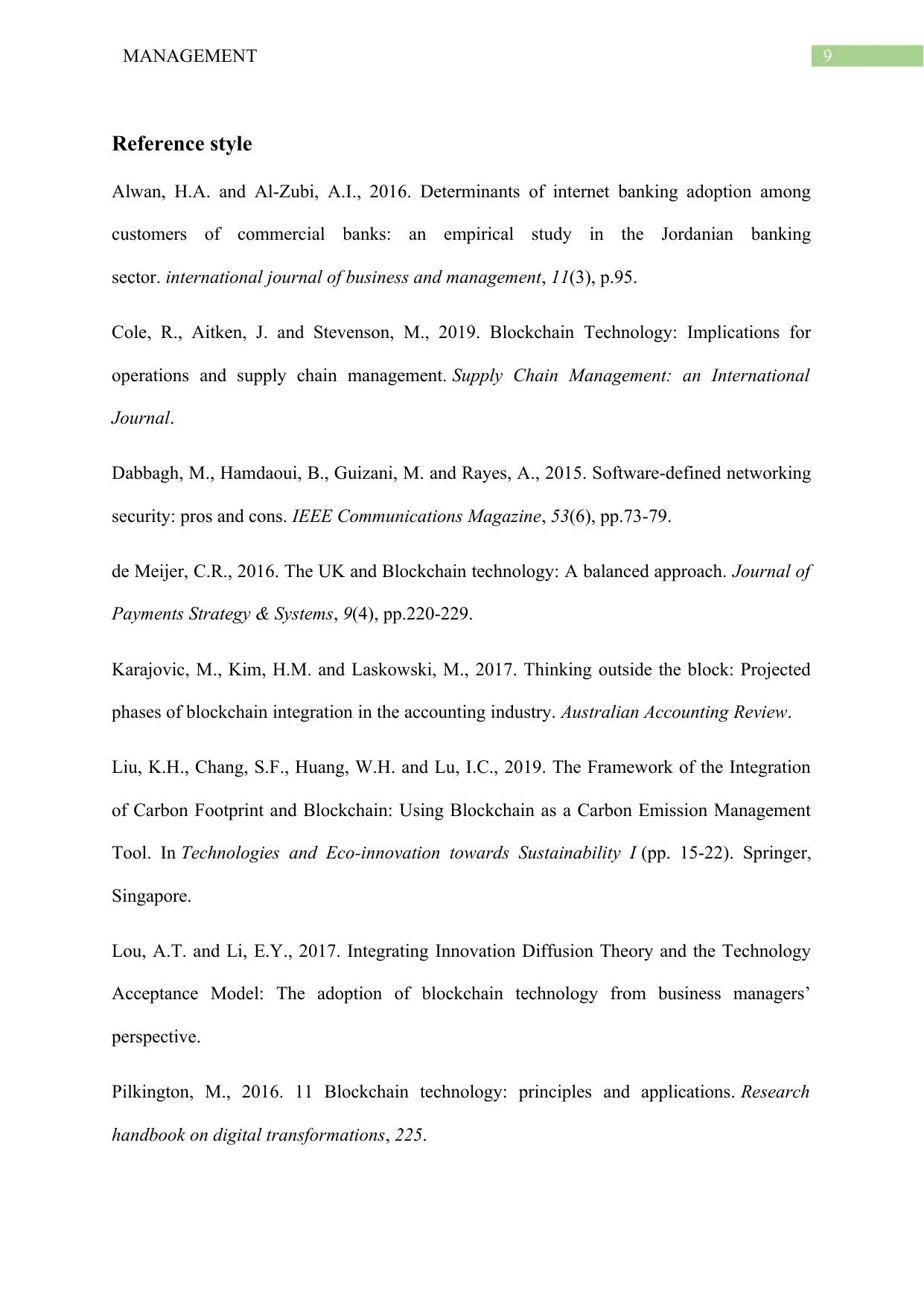
9MANAGEMENT
Reference style
Alwan, H.A. and Al-Zubi, A.I., 2016. Determinants of internet banking adoption among
customers of commercial banks: an empirical study in the Jordanian banking
sector. international journal of business and management, 11(3), p.95.
Cole, R., Aitken, J. and Stevenson, M., 2019. Blockchain Technology: Implications for
operations and supply chain management. Supply Chain Management: an International
Journal.
Dabbagh, M., Hamdaoui, B., Guizani, M. and Rayes, A., 2015. Software-defined networking
security: pros and cons. IEEE Communications Magazine, 53(6), pp.73-79.
de Meijer, C.R., 2016. The UK and Blockchain technology: A balanced approach. Journal of
Payments Strategy & Systems, 9(4), pp.220-229.
Karajovic, M., Kim, H.M. and Laskowski, M., 2017. Thinking outside the block: Projected
phases of blockchain integration in the accounting industry. Australian Accounting Review.
Liu, K.H., Chang, S.F., Huang, W.H. and Lu, I.C., 2019. The Framework of the Integration
of Carbon Footprint and Blockchain: Using Blockchain as a Carbon Emission Management
Tool. In Technologies and Eco-innovation towards Sustainability I (pp. 15-22). Springer,
Singapore.
Lou, A.T. and Li, E.Y., 2017. Integrating Innovation Diffusion Theory and the Technology
Acceptance Model: The adoption of blockchain technology from business managers’
perspective.
Pilkington, M., 2016. 11 Blockchain technology: principles and applications. Research
handbook on digital transformations, 225.
Reference style
Alwan, H.A. and Al-Zubi, A.I., 2016. Determinants of internet banking adoption among
customers of commercial banks: an empirical study in the Jordanian banking
sector. international journal of business and management, 11(3), p.95.
Cole, R., Aitken, J. and Stevenson, M., 2019. Blockchain Technology: Implications for
operations and supply chain management. Supply Chain Management: an International
Journal.
Dabbagh, M., Hamdaoui, B., Guizani, M. and Rayes, A., 2015. Software-defined networking
security: pros and cons. IEEE Communications Magazine, 53(6), pp.73-79.
de Meijer, C.R., 2016. The UK and Blockchain technology: A balanced approach. Journal of
Payments Strategy & Systems, 9(4), pp.220-229.
Karajovic, M., Kim, H.M. and Laskowski, M., 2017. Thinking outside the block: Projected
phases of blockchain integration in the accounting industry. Australian Accounting Review.
Liu, K.H., Chang, S.F., Huang, W.H. and Lu, I.C., 2019. The Framework of the Integration
of Carbon Footprint and Blockchain: Using Blockchain as a Carbon Emission Management
Tool. In Technologies and Eco-innovation towards Sustainability I (pp. 15-22). Springer,
Singapore.
Lou, A.T. and Li, E.Y., 2017. Integrating Innovation Diffusion Theory and the Technology
Acceptance Model: The adoption of blockchain technology from business managers’
perspective.
Pilkington, M., 2016. 11 Blockchain technology: principles and applications. Research
handbook on digital transformations, 225.
Paraphrase This Document
Need a fresh take? Get an instant paraphrase of this document with our AI Paraphraser
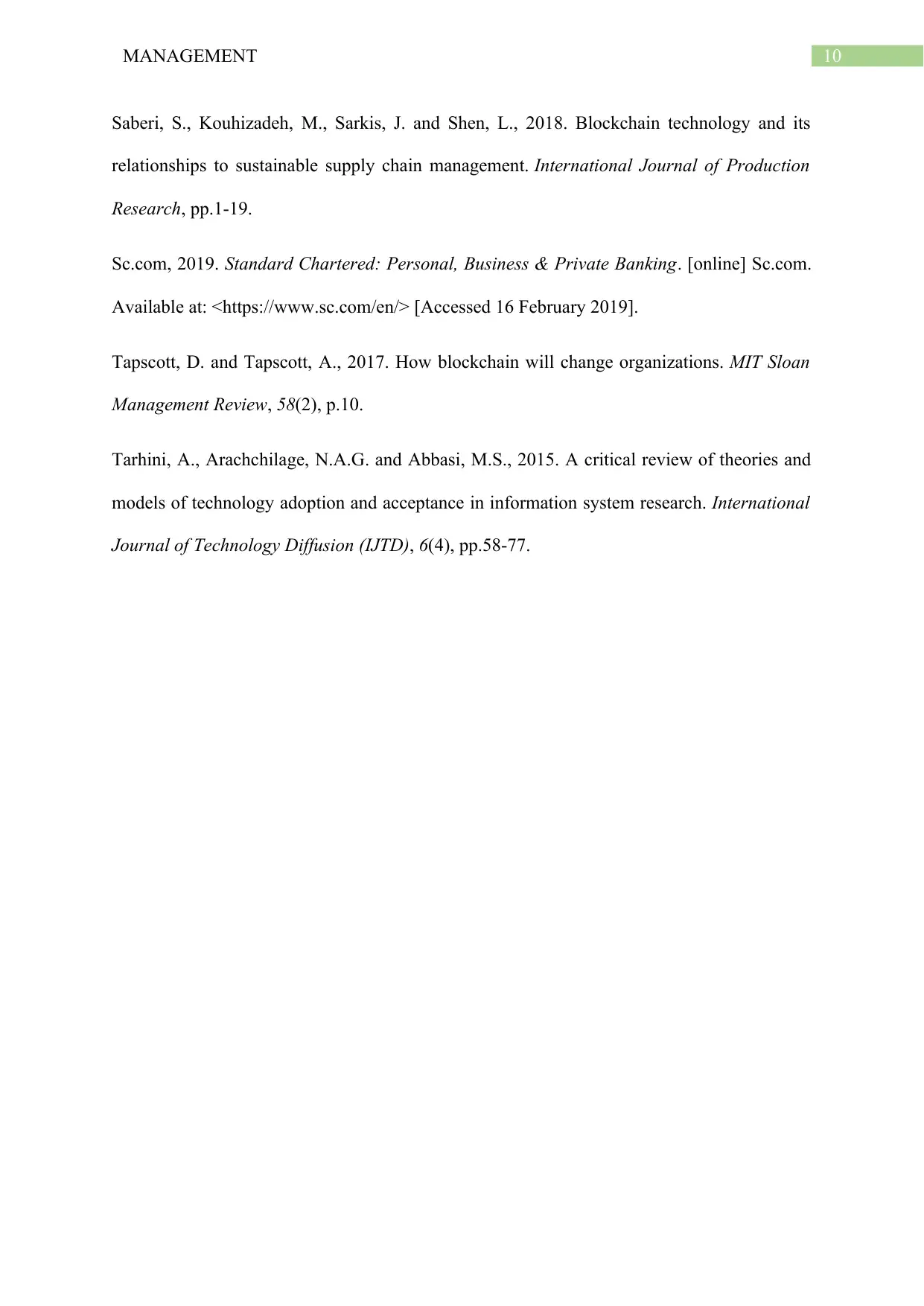
10MANAGEMENT
Saberi, S., Kouhizadeh, M., Sarkis, J. and Shen, L., 2018. Blockchain technology and its
relationships to sustainable supply chain management. International Journal of Production
Research, pp.1-19.
Sc.com, 2019. Standard Chartered: Personal, Business & Private Banking. [online] Sc.com.
Available at: <https://www.sc.com/en/> [Accessed 16 February 2019].
Tapscott, D. and Tapscott, A., 2017. How blockchain will change organizations. MIT Sloan
Management Review, 58(2), p.10.
Tarhini, A., Arachchilage, N.A.G. and Abbasi, M.S., 2015. A critical review of theories and
models of technology adoption and acceptance in information system research. International
Journal of Technology Diffusion (IJTD), 6(4), pp.58-77.
Saberi, S., Kouhizadeh, M., Sarkis, J. and Shen, L., 2018. Blockchain technology and its
relationships to sustainable supply chain management. International Journal of Production
Research, pp.1-19.
Sc.com, 2019. Standard Chartered: Personal, Business & Private Banking. [online] Sc.com.
Available at: <https://www.sc.com/en/> [Accessed 16 February 2019].
Tapscott, D. and Tapscott, A., 2017. How blockchain will change organizations. MIT Sloan
Management Review, 58(2), p.10.
Tarhini, A., Arachchilage, N.A.G. and Abbasi, M.S., 2015. A critical review of theories and
models of technology adoption and acceptance in information system research. International
Journal of Technology Diffusion (IJTD), 6(4), pp.58-77.
1 out of 11
Related Documents
Your All-in-One AI-Powered Toolkit for Academic Success.
+13062052269
info@desklib.com
Available 24*7 on WhatsApp / Email
![[object Object]](/_next/static/media/star-bottom.7253800d.svg)
Unlock your academic potential
Copyright © 2020–2025 A2Z Services. All Rights Reserved. Developed and managed by ZUCOL.





